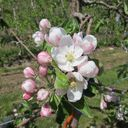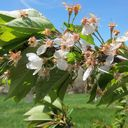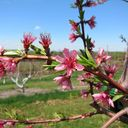Current (through May 9) degree day (DD) Accumulations
Location: UMass Cold Spring Orchard (CSO), Belchertown, MA
Base 43: 344
Base 50: 192
Significant upcoming orchard insect events based on degree days (Base 43):
Redbanded leafroller 1st flight peak: 231-365
Spotted tentiform leafminer 1st flight peak: 264-394
Spotted tentiform leafminer sap-feeders present: 343-601
European red mite egg hatch: 231-337
Oriental fruit moth 1st catch: 222-324
Oriental fruit moth 1st flight peak: 350-552
Lesser appleworm 1st catch: 263-567
Codling moth 1st catch: 400-578
McIntosh at bloom: 346-418
Current bud stages
| Location |
McIntosh apple -- |
Gold Bosc pear -- bloom+ |
Burgundy (Pearl) cherry -- petal fall | PF14 Jersey peach -- late bloom |
|---|---|---|---|---|
| Belchertown UMass CSO (05/09/11) |
 |
 |
 |
 |
Orchard Radar insect synopsis
Note: beginning with this issue of Healthy Fruit we will be reprinting apple insect degree-day model highlights from Glen Koehler's (U. of Maine) Orchard Radar output for Belchertown, MA.
- 1st Lesser Apple Worm (LAW) flight begins around: May 11, Wednesday. Peak trap catch: May 22.
- 1st generation Oriental Fruit Moth (OFM) flight starts: May 3, Tuesday. 1st generation - 55% egg hatch and first treatment date, if needed: June 1, Wednesday.
- Increased risk of Plum Curculio (PC) damage as McIntosh and similar cultivars increase fruit size:
May 22, Sunday. Earliest safe date for last PC insecticide spray: June 3, Friday. - Peak trap catch Redbanded Leafroller (RBLR) and approximate start of egg hatch: May 4, Wednesday.
- San Jose Scale (SJS) first adult caught on trap: May 18, Wednesday.
- Spotted Tentiform Leafminer (STLM):1st STLM flight, peak trap catch: May 12, Thursday. 1st generation sapfeeding mines start showing: May 22, Sunday. Optimum sample date is around Tuesday, May 24, when a larger portion of the mines are visible.
- 1st generation White Apple Leafhopper (WAL) found on apple foliage: May 14, Saturday
- Sunday, May 1 McIntosh 95% petal fall; Wednesday, May 5 fruit set
Upcoming meetings
May 17, 18, 19: Tree fruit twilight meetings
May 17, UMass Cold Spring Orchard, 391 Sabin St., Belchertown, MA.
May 18, Lavoie's Farm, 172 Nartoff Rd., Hollis, NH.
May 19, Narrow Lane Orchard, 213 Narrow Lane, North Kingston, RI.
Tree fruit twilight meetings start promptly at 5:30 PM.
Pesticide recertification credit(s) will be offered.
There will be a $25 meeting admission charged at the door. (MA and RI meetings only. $20 for Massachusetts and Rhode Island Fruit Growers' Association FULL members.)
A light meal or snack is typically served at all meetings.
May 20: UMass Good Agricultural Practices Training, Berkshire Room, University of Massachusetts Collaborative Services Facility, 333 South Street, Shrewsbury, MA 01545-4169. Pre-registration required at dyork@umext.umass.edu.
June 14, 15, 16: Tree fruit twilight meeting, TBA
July 18, 2011: Massachusetts Fruit Growers' Association Summer Meeting, Parlee Farms, Tyngsoboro, MA
The way I see it
Counting out the incessant wind, we have been having a pretty nice stretch of weather moving into apple bloom. (At least in west-central Massachusetts. Your results may be different.) Bees should be in the orchard by now, and barring any major change in the forecast we should get through bloom in fine shape.
The post-bloom period has lots of issues to face: beginning of insecticide sprays for most, fruit thinning, calcium application, etc. Perhaps most pressing and important is the issue of fruit thinning. Thus, the article below by Duane Greene you will find timely.
Finally, just a quick statement: the risk of fire blight infection appears to be low at this time. That may change as the weather forecast changes, however, for now, no worry. I will keep you updated with any change in status.
JC
2011 New England Tree Fruit Management
As a reminder, the 2011 New England Tree Fruit Management Guide is still available for purchase.
The 2011 New England Tree Fruit Management Guide (NETFMG) is available NOW. For $50 you will receive the printed guide by postal mail. You can download and print a mail-in form to order the NETFPMG by personal check here.
Note that for 2011 the herbicide/weed control section has been completely revised, and all sections have been carefully reviewed for changes in 2011. Order yours today!
Also note that Commonwealth Quality produce certified growers should have the 2011 NETFMG in their possession to achieve the maximum score!
JC
Updated Trac pesticide recordkeeping software available
Updated for 2011 Trac pesticide recordkeeping software from the New York State IIPM Program for tree fruit (apple, cherry, peach-nectarine, and plum) is now available for purchase.
It's my opinion TracApple, TracPear, TracCherry, and TracStoneFruit are the best pesticide recordkeeping applictions available, and well worth the purchase price. A single Trac software is $60;
the TracTreeFruit Bundle that includes TracApple, TracPear, TracCherry and TracStoneFruit is $180.
JC
Preparing for Life Without Carbaryl
Duane Greene, UMass Amherst
All production of carbaryl in the United States was stopped earlier this year. Therefore, carbaryl used in the United States from now on will be imported. Further, carbaryl can no longer be used in many countries in Europe. These events are interpreted by many to mean that carbaryl may no longer be available for use in the very near future. Since you do have carbaryl still available now there is no panic. However, in anticipation of the loss of carbaryl, this may be a good time to evaluate alternatives in your own orchard so that you will be able to more comfortably and with some degree of confidence move to a thinning program that does not include carbaryl.
Bloom is approaching or has arrived, thus your first thinning spray of the years will soon be applied. Carbaryl has been the most popular petal fall thinner and most growers do depend heavily on this thinner at petal fall. I have stated previously that the petal fall treatments may be the most important thinner application since it sets the stage for subsequent thinner application(s) and it generally allows for less aggressive thinner applications later. In the absence of carbaryl, thinning at this timing may take on added and increased importance and urgency.
At petal fall fruit growth is extremely slow. Fertilization of ovules has or is taking place. Following fertilization there is a period of time when the fertilized ovule undergoes cell division and starts to produce the hormones which are largely responsible for the driving of fruit growth. Generally this slow growth period lasts for 6 to 7 days. Since the growth of fruit is slow the demand for photosynthate by fruit is also relatively low. It is for this reason, in part, that thinning activity of thinners applied at petal fall is generally less than at the later and more traditional 10 mm timing. Higher rates of thinners can and should be used at petal fall since these higher rates will be necessary to achieve meaningful thinning at petal fall.
Thinner Options
NAA This is a thinner that all are familiar with since it has been in common use for many years. It is less active at petal fall, so higher rates should be used. My rule-of-thumb is to apply twice the concentration of NAA at petal fall that you would consider using at the 10 mm stage. I am suggesting a base level of 10 ppm to start with. In some circumstances 15 or 20 ppm may be appropriate.
Amid-Thin Amid-Thin is no longer routinely used. In the New England Tree Fruit Management Guide it is recommended for use only as a petal fall spray on Early McIntosh, Lodi, Quinte and Yellow Transparent. It is time to resurrect this thinner, at least on a trial basis. Amid-Thin was evaluated as a thinner with NAA in the 1950s. When compared with NAA at the 10 mm timing it was less effective, so NAA became the product of choice. Amid-Thin also produces pygmy fruit on some varieties (Delicious) especially when applied at the 10 mm stage. It was evaluated as a petal fall spray during development and it was found to be quiet effective. Since thinning was generally done only once during that fruit growing era, and greater thinning was achieved with a 10 mm application, the use of Amid-Thin was relegated to use as a petal fall spray on early varieties and Macoun. Petal fall application of thinners did not come into general used until recently and Amid-Thin was long-forgotten by then. I am suggesting that you may want to consider evaluation of Amid-Thin as a petal fall spray in lieu of carbaryl. The suggested rates would be 25 to 50 ppm.
Promalin This is used in some circumstances as a thinner at bloom especially at the 2 pt/100 gal rate with a surfactant on Delicious. This is also commonly used on Gala in Chile and Washington. The thinning action is generally not strong and higher rates with the surfactant may increase thinning activity but it may also reduce return bloom.
MacCel MaxCel is generally not recommend for use at petal fall because if does not thin nearly as well or effectively at this time. Where increased fruit size is desired, a spit application may be useful, but this is infrequently done.
Ethrel While the use of this compound is generally reserved to those who are not faint-hearted, it is an effective bloom/petal fall thinner. Ethrel differs from other thinners in that it thins at bloom/petal fall and at the 20 mm stage but is less effective at the 10 mm stage.